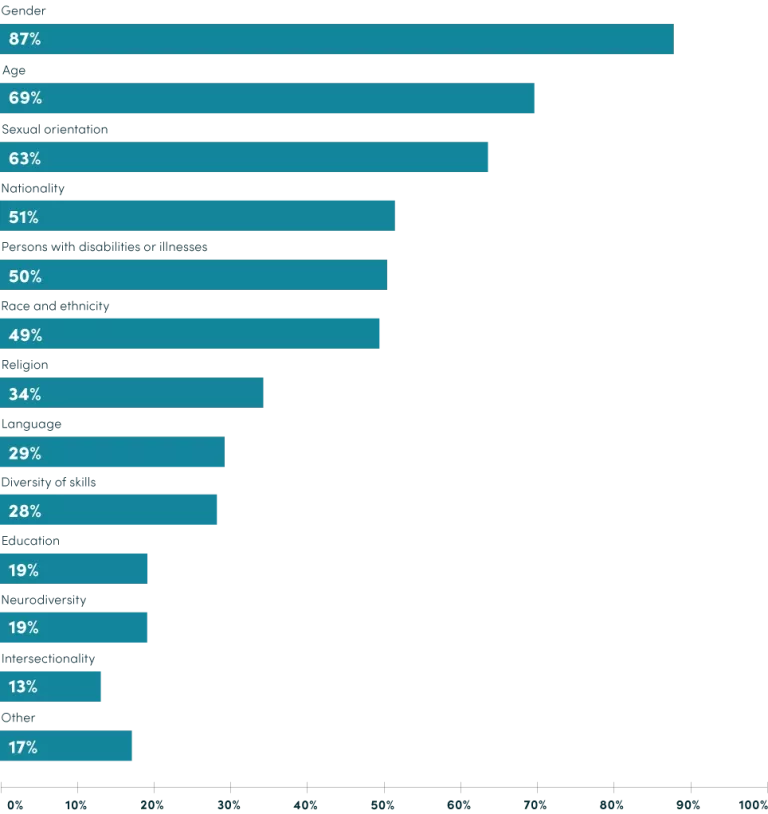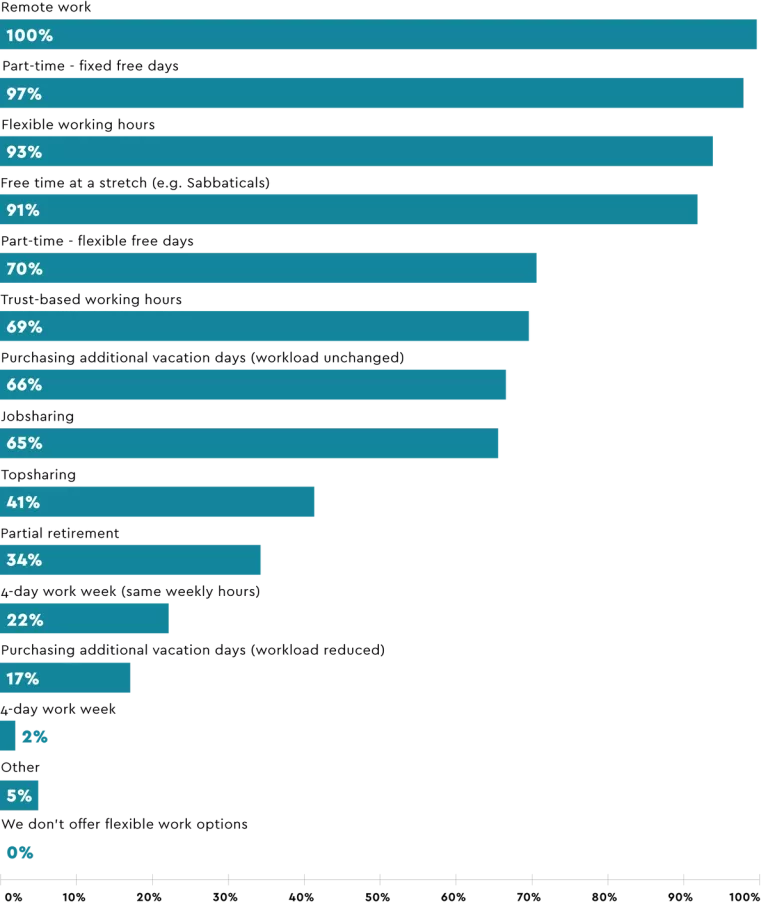Every year, we want to know: How are Swiss companies championing I&D? What are Swiss organizations doing to build inclusive cultures and foster inclusive leadership?
Most Swiss organizations still prioritize diversity over inclusion. Since equity is becoming more and more popular, this was analyzed for the first time this year. This concept is less common but shows a similar pattern with being mostly anchored in companies’ HR strategies. As ESG strategies are becoming more widespread, the 2024 survey also included that as a possible answer. Approximately a third (equity) to half (diversity) of the organizations anchor DE&I (also) in an ESG strategy.

More companies feature diversity than inclusion or equity as part of their HR strategy, DE&I strategy, corporate strategy, or all the above. On the one hand, slightly over half of participating companies mention inclusion and diversity as part of an explicit corporate strategy, while less than half include the concept of equity. About one third tie these concepts into their mission statement and core purpose. This difference in strategy and statement shows an understanding that DE&I may provide benefits to strategy, but are not part of many organizations core values or mission.
Looking at the diversity dimensions explicitly named in GIR companies’ strategies provides insight into what dimensions are the focus of I&D efforts in different companies. The dimensions mentioned most frequently are gender, age, and sexual orientation, as was already the case in 2023. Approximately half of the companies mention nationality, persons with disabilities or illnesses, and race and ethnicity in their strategy. This is also similar to last year. However, this year there was a noticeable drop in the recognition of “language” and “diversity of skills” as dimensions listed in companies’ strategies.

Trends in I&D networks and employee resource groups follow a very similar pattern. Most companies have ERGs for women, followed by LGBTQI+ employees and networks for employees interested in I&D. This trend is similar to last year, even though the percentage of companies having ERGs for women decreased a bit. The share of companies with ERGs for younger employees or recent graduates, persons with disabilities or illnesses and racial and ethnic minorities remain similar as in 2023.
Notably, 27% of GIR companies don’t have any employee networks or ERGs. Again, this is similar to last year’s GIR. For some companies, this might be due to their smaller size.

64% of companies have measurable inclusion goals. While this number may seem high, it is still lower than those companies with measurable diversity goals (78%). Companies focusing on diversity goals without the combination of inclusion goals may promote assimilation into the old organizational culture rather than a sense of value and belonging for diverse employees (Shore et al., 2011). The trend that more companies have diversity than inclusion goals is similar to 2023, however, the difference between the two increased slightly.
What gets measured gets done. Approximately three quarters of GIR companies regularly report on I&D.
Goals hold managers accountable for fostering a diverse workforce and inclusive culture in their teams and units. Inclusion goals for managers may include proven conflict resolution skills, participation in inclusion trainings (e.g., psychological safety or inclusive leadership), team-level results of engagement surveys related to inclusion, etc. Diversity goals hold managers accountable for diversity in their teams and units.
Though only 36% of companies have measurable inclusion goals for managers, and 49% of GIR companies have diversity goals, this is a minimal increase from last year. At the same time, this is approximately half the number of companies who in general have I&D goals. If not managers, who could be responsible for achieving organization-wide I&D goals?
Compared to 2023, fewer companies are offering unconscious bias trainings for managers and HR professionals. However, it does seem like trends in offering unconscious bias trainings for all employees have not changed. Are unconscious bias trainings more streamlined, rather than specialized workshops for HR and managers? Or were these trainings more a one-off initiative?
Companies have adapted to a new way of work, as all GIR companies offer remote work options. Most companies also offer fixed part-time days, flexible working hours and sabbaticals are common.
65% of companies offer jobsharing for non-leadership positions and 41% offer topsharing. This difference shows that leadership is still considered a one-person, full-time job. And in contrast to many other European countries, the four-day workweek is not common in Switzerland.
In general, the results on flexible work options are very similar as last year.

The average GIR company offers more parental leave than is legally required: 17.5 weeks for mothers, 4.3 weeks for fathers, and 9.5 weeks for adoption. The contrast between maternity and paternity leave shows a rather traditional attitude towards caregiving and provider roles for women and men, that is also reflected in the Swiss legal structures. Only 22% of the companies offer parental leave (i.e., shared leave entitlement).

34% of GIR companies do not support their employees’ childcare in any way, even though Switzerland has an expensive and complex childcare system. Among companies that do provide support, 59% provide financial support. Only 18% of GIR companies have their own childcare facility.

While it seems to become more commonplace to anchor inclusion and diversity in companies’ DNA, GIR companies show little progress when it comes to gender diversity. How can we quicken this progress? In this year’s focus topic, we call on companies to change power dynamics to increase the representation of women in leadership roles. These measures will not only help women and other (in leadership roles) marginalized groups advance, but also contribute to a better organizational climate.